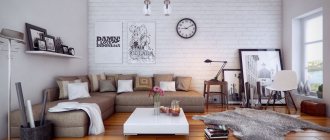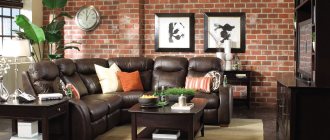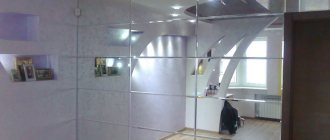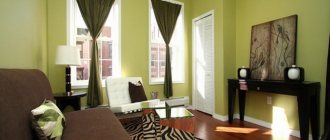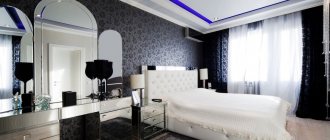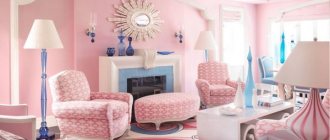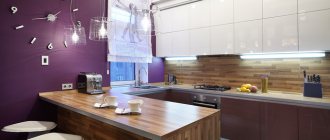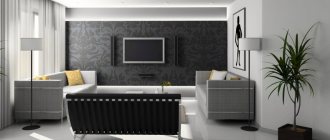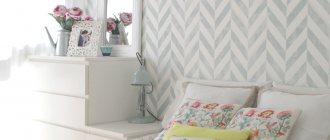The brick wall in the living room has become the hallmark of the loft, a manifestation of the extravagance and non-trivial taste of the owners of the house. The design, born in the 40s of the 20th century, continues to win an army of fans. Despite its simplicity, the industrial-urban direction is one of the most expensive types of residential design.
A brick wall in the interior allows you to add zest to the design of your home in an affordable way.
With the light hand of designers, brickwork has become a fashionable element of the interior. To the envy of the loft, other design styles decided to keep up and also borrowed a brick wall. Now it is being “introduced” into minimalism, hi-tech, country, Provence and Scandinavian style. Yes, and what’s more, the classics themselves have descended into newfangled trends. Provided that it is properly designed, such a decorative element turns a traditional interior into a neoclassical one. It gets along with arched structures and pilasters, massive oak furniture and monochrome pastel colors.
Brick walls have long been firmly established in modern interiors as a key element of the loft style and an indicator of the good taste of the owner of the house.
A selection of real photos of living rooms with a brick wall
It's better to see once than to hear a thousand times. Visually appreciate how impressive a room with a brick wall looks.
Advantages and disadvantages
A brick wall in the living room interior is a way to deceive the space. Visually, it looks like a natural continuation of the facade of the house. The combination of brick and wallpaper allows you to delimit the space into several islands, thereby highlighting functional areas. Bare brick without additional finishing looks like a shocking and decorative element of the interior.
It is an expression of the building's rich historical past, a blend of past and present.
Main advantages:
- creates a 3D effect;
- fits into many design trends;
- looks presentable.
Regardless of the type of masonry, a brick wall is always embossed. Against the background of aligned walls, this technique looks impressive. No one will be able to pass by the industrial island in a cozy home. Guests and household members every now and then glance at the contrasting wall. Even if it is made in the same color as other walls, its texture will not go unnoticed.
The presence of a brick wall in the living room is a manifestation of individuality and elegance as opposed to already boring interiors with a predominance of glass and stone finishing.
A brick wall will be the highlight of almost any interior. It is enough to choose a stylistic direction, select the appropriate furniture and decorative elements. The main thing is to place the accents correctly, to put brick design at the forefront.
In addition to its aesthetic purpose, a brick wall has the same qualities as the original material. Its strengths include:
- strength;
- long service life;
- excellent thermal insulation and sound insulation properties;
- ease of maintenance and care (we are talking about impregnated bricks that do not absorb dust and do not accumulate dirt).
A living room with brick walls can be much more visually appealing, and furniture in neutral colors will stand out more.
Important! All of the above properties are generalized. Based on the raw materials and production method, it is customary to distinguish bricks by thermal, insulating and acoustic qualities.
Disadvantages of a brick wall:
- heavy construction;
- visually narrows the space.
The disadvantages can be mitigated in several ways:
- change of material;
- color design;
- selection of the method and the original pattern of the brickwork.
A dynamic option would be a brick wall in a deep gray shade or even black - which would be a frankly bold decision.
The imitation of a brick wall is visually no different from the original idea. This is done using:
- tiles;
- panels;
- plasters;
- wallpaper
White brickwork always looks advantageous and neutral.
In the design of decorative brick blocks, achromatic colors and shades of a warm palette are most often used. These include:
- white, gray and black;
- ocher, sand, straw,
- terracotta, beige-pistachio, chocolate.
A brick wall in the middle of a room is a real decorative composition that can be played out in an original way, taking into account all the features of the room.
Important! To narrow the space, use black or white brick in your living room interior. Such colors “stretch out” the wall, while warm shades of red and yellow, on the contrary, expand the room.
How to choose wallpaper for a brick wall?
The brick wall is the highlight of the room. It does not require additional decor, and in itself is an attractive element of the interior. The wallpaper that covers the remaining walls should set off the brickwork or echo it in unison. This means that they should be a contrasting color or the same color as the brick, but a shade lighter.
The color of the brick can be very different, the main thing is that it is in harmony with the overall decor of the interior.
Loft is an original style that does not tolerate excesses. Everything here is simple and clear. It is characterized by conciseness, free space and a single color scheme. Following the canons of the urban direction, use one color and several shades of it. A monochrome interior has the right to life, but with one caveat: if all the walls are the same color, then the brickwork should be decorated with photographs or paintings.
Brick, as well as its imitation, in the design of a room looks original, fashionable and beautiful.
A living room that combines white and black, or gray and black, looks beautiful. In this case, the contrast of the achromatic scale is reminiscent of the Yin-Yang concept. If you are passionate about creating a loft, then choose wallpaper in pastel and cool colors to get a light and muted interior.
A fireplace against the backdrop of a brick wall immediately transports you to the times of towers and castles.
Important! Street style combines effectively with wallpaper depicting graffiti. This option appeals to young people and creative people.
Grunge fans who are ready to combine several styles into a single whole are allowed a lot. They can deviate from established rules and boldly experiment with colors.
If the loft is characterized by a monochromatic covering, then grunge is prone to wallpaper with ornaments.
Important! To ensure that the brickwork fits harmoniously into the room, choose wallpaper with a fine pattern.
The location of the wall on which the brick will be placed also matters. It can be central or lateral. In the first case, choose wallpaper that is a lighter tone, in the second - brighter. Most often, luscious coatings are chosen for functional walls on which a TV or fireplace will be placed. When the TV equipment is located on brickwork, the wallpaper should be monotonous or with a small pattern.
A plasma TV screen on a stylish wall gives the room the warmth of a home.
The hall in a residential building is a place where the whole family gathers. It offers a relaxing environment characterized by vibrant colours. Choose wallpaper based on your own taste and design.
Interesting ideas
So, let's see what we can do to unusually decorate the walls with decorative stone and wallpaper in the hallway?
- Apply jagged edges to make the walls look voluminous.
- Install spotlights to highlight the cladding.
- Add various decorations to the wall. Mirrors, paintings, fakes and compositions will be used.
- Create a living corner.
- In the classical direction, place stone on the columns, emphasizing the overall ambiance.
- Hang shelves to store small items.
Where and how to use brickwork in the interior?
Imitating the outer wall of a house in a living space makes it possible to create an exclusive and fashionable design. Using facing bricks, clinker tiles or brick-like wallpaper, think about the location of the main highlight of the interior.
Brickwork can divide a room into zones and be placed in niches and separate islands in the room. It is appropriate in large houses and small apartments.
A brick wall in the interior of the living room does not require additional decoration, since it itself is a decoration in the interior of the room.
As partitions, it is applicable in places where the hall is combined with a dining room or kitchen work area, or in apartments in which the hallway goes into the hall. To create an artificial wall or stand, it is enough to make a ceiling from plasterboard.
In separate niches it can be made to accommodate a TV, fireplace, phytowall, home photo gallery, video library or audio library.
A living room with a brick wall is an alternative to using masonry as interior decor.
As an original element of the interior, it can be located as a separate block on any wall or between window openings. In this case, you can paint it in any colors, use the free space to place a wall clock and more.
A wall made of classic red brick certainly looks aesthetically pleasing and takes its leading place in a modern living room.
Important! Do not forget to fill the brick wall with objects so that it does not become empty.
There are several popular options for using brick for a hall.
- Imitation of facade. The method consists of creating a custom wall, which will be complemented by arched windows and niches. At the same time, it will not be used functionally; it performs only an aesthetic function. The geometry of the allocated space is emphasized by dramatic changes in direction or type of installation. Most often, a niche or window area is laid out with small bricks, and the remaining surface with large bricks.
They are experimenting with a row of bricks in the area of the window frame and window sill, forming a narrow frame that is characteristic of the outer walls of the house.
- Artificial aging. The owners of old-style apartments were incredibly lucky in this case. They don’t have to make any effort; just remove a layer of plaster and decorate the wall. But residents of a new building will have to work harder to get a vintage surface. It can be used to place a TV or as partitions between zones. Here one square looks ultra-modern, while the other looks like echoes of the past.
Deliberate aging of the coating allows you to create a “back to the future” effect.
- Partial installation. This technique is necessary for the owners of “Khrushchev” buildings, smart apartments and other small-sized housing. Having a small amount of square meters, household members have to allocate space in the living room for relaxation, work and dining areas. To snatch a piece of free space, you can delimit the rooms into areas or demolish a wall, combining the corridor with the living room or kitchen. In this case, it is not necessary to adhere to symmetry and strict lines.
In order for the stone to have a neat and attractive appearance, the wall must be treated with brick impregnation.
- Brutality VS Femininity. Oddly enough, brick is suitable for both the stronger sex and representatives of the fair half of humanity. The statement that a brick wall fits into any interior is true, but with a caveat. If you live alone, you can focus on your gender identity. If you live with a family, then the wall can be designed in the form of a confrontation between the sexes. One part should be smoothed, puttied and painted in a pastel shade, and the other should be left in its original form or as close to it as possible.
This option will be the final touch to decorating a wall against which you can lean a sofa or place a TV on it.
- Fireplace portal. Choose a place for the fireplace, the visible frame of which will carry a decorative load. Brick will come in handy. The environmentally friendly material is safe for health and suitable for use in residential areas.
It is worth noting that a living room with a brick wall made of artificial stone looks quite original and is an excellent option for accenting part of the interior.
Homemade tiles
You can make tiles that imitate brick with your own hands. At the same time, it will look as realistic as possible. No special costs will be required - you can use the most affordable materials.
For example, polystyrene foam is suitable. It can be easily cut with a knife, pasted on walls and painted. On the Internet you can find many videos with master classes on creating foam bricks.
However, this material also has disadvantages: it is fragile and rather fragile, and does not have the ability to withstand mechanical stress.
You can also make rectangular parts that imitate real brick from wood, plaster, or cement. After covering the walls with homemade tiles, the seams must be filled with silicone sealant using a mounting gun.
In addition, dry plaster or tile adhesive is suitable. The mixture should be placed in a plastic bag, cutting off a corner of it, and, carefully squeezing out, fill the seams between the tiles.
What brick to use for wall decoration?
The design of a room with a brick wall is worth considering. First, choose a location and type of decoration. Will the brick fill the entire wall or appear in patches? Remember that the material is quite bulky and draws attention to itself. Having decided on the location, move on to the essentials - the material. Brick is used for wall cladding:
- red;
- white;
- facing;
- decorative.
Important! Using natural brick to decorate a room has a lot of disadvantages: labor-intensive work, narrowing of space, load on the floor.
Red brick is the most common. It is chosen in various shades, ranging from light orange to brown-brown. It conveys the idea of a loft and the spirit of the times when people inhabited industrial premises. Despite this, white brick continues to be an element of minimalism, country, Provence and Scandinavian style.
The beauty of brick walls brings warmth to a small living space and makes it feel invitingly homey.
Facing colored brick is thinner than ordinary building brick, but more than decorative. It requires less space than conventional construction material, is intended for finishing surfaces, and is suitable for creating partitions.
In addition to masonry, you will need a primer and a coating of clear acrylic varnish.
When an apartment needs redevelopment, choose facing bricks. It can be glazed, that is, with a smooth front surface, or embossed. For cladding load-bearing walls, they use bricks with a double-sided coating (spoon and poke), for the construction of a partition - with a four-sided one, in order to get beautiful masonry in two rooms. This way you can save on consumables.
Using facing bricks on artificially created walls with a small thickness, you do not have to spend money on decorative finishing materials.
Decorative brick comes in a variety of textures, shapes, sizes and colors. It does not take up much space, is easy to process, and can be laid on durable surfaces without complex equipment.
This type of brick is appropriate on open walls and is used for aesthetic purposes.
When choosing between materials, focus on the end result and budget. Inexpensive options would be tiles and brick-like wallpaper, but they also have their drawbacks.
Rough brickwork in modern living rooms - 50 photos:
Get inspired by the daring loft style and enjoy the selection of photos.
Romantic style
Contrary to popular belief, imitation brickwork is suitable not only for decorating rooms in a minimalist style.
- Sometimes this design allows you to create a romantic atmosphere.
- In this case, the key to success is properly organized lighting, beautiful textiles, interesting accents and color harmony.
- Even a loft-style interior can be transformed into a romantic one.
To create the right mood, use live and artificial plants, paintings and panels of appropriate themes, beautiful large vases and candlesticks.
